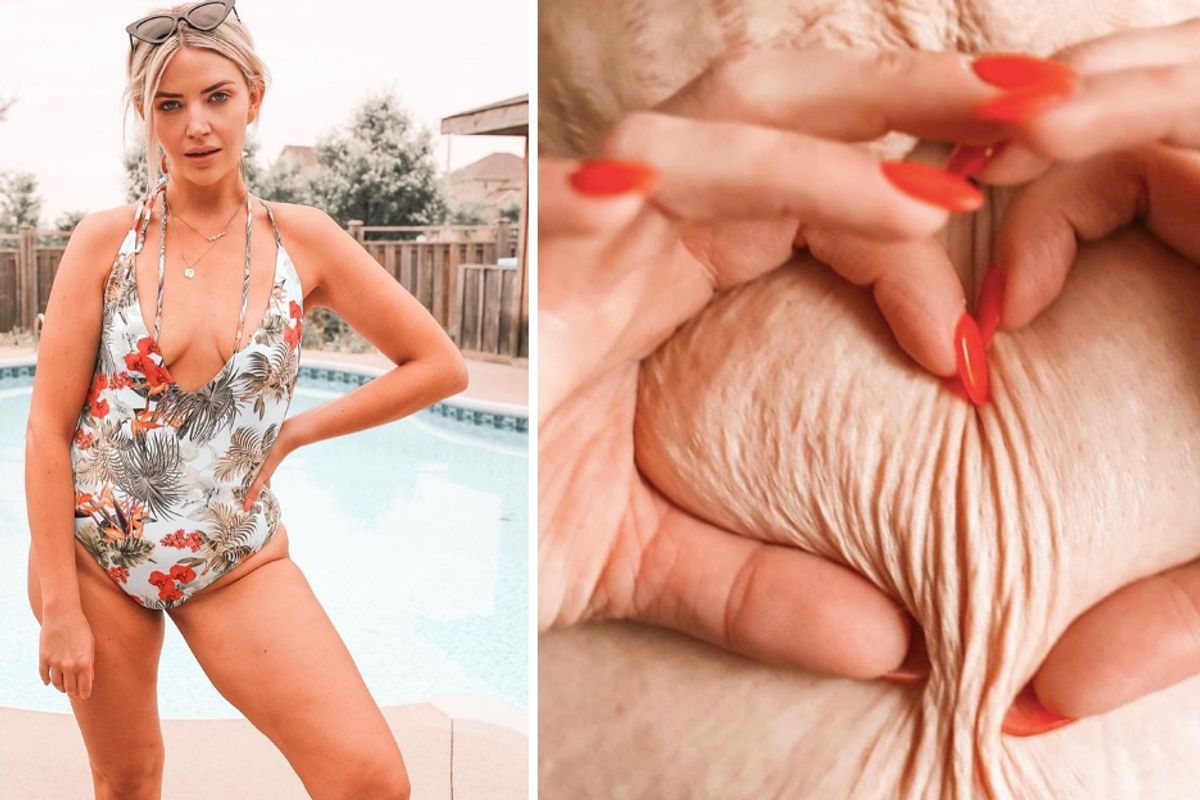Sarah Nicole Landry's awesome as-is body photos are a vital message for swimsuit season.

Swimsuit season is a time great angst for many women. But it doesn't have to be this way.
Some of us do a pretty good job of appreciating our bodies, right up until it's time to put on a swimsuit. Then the questions start flying: Does this suit make me look chunky? Do my boobs look weird? Do my thighs look like cottage cheese? Is my pooch too obvious? Is my butt too big?
After that come the "Ugh, look" statements. Ugh, look at that cellulite. Ugh, look at that roll. Ugh, look at that back fat, those saddlebags, those cankles.
And finally, the judgments. I'm too out of shape. I should cover that up. No one wants to see that. My [fill in the body part] looks so gross. I'm too embarrassed to be seen like this.
This woman's powerful 'before and after' photos crush myths about body positivity.
And there it is. The swimsuit season body bashing that comes too easily to too many of us. We know it's not healthy to do this to ourselves. We know that we should love our bodies even if they aren't perfect. We know that we don't need to look like a Victoria's Secret model to go to the beach… and yet we end up back at this familiar place in front of the mirror every summer.
Sometimes we need a firm reminder that the way our bodies look in a swimsuit isn't something we need to fret about. Like, at all.
Sarah Nicole Landry's awesome as-is photos of her body come with this vital message.
Landry is the woman behind The Birds Papaya—a blog, an Instagram page, and a newly minted podcast—and her take on body positivity is inspiring thousands.
For example, in a post on Instagram, Landry shared a photo of the skin on her belly squished into a heart with her fingers.
"Many of us have skin like this," she wrote, "From whatever growth or change happened in our bodies.
Skin that wrinkles and folds, yet is soft and delicate. Skin that did a good job. Skin that did exactly what it was supposed to do."
"Sharing this was not an act of bravery," she wrote. "It was a moment of me wanting to show up and share something that I'd come to learn was normal. It was from the desire to find connection and peace in my own body by freeing myself of the holds of a lie that said this skin, MY SKIN, was the reason why I could never have a 'good body.'"
Another photo she shared on Facebook and Instagram is resonating with thousands as we slide into swimsuit season.
It's a picture of Landry by the pool in a one-piece swimsuit, looking gorgeous—but not "model-perfect."
Landry's message with the photo drives home the point that we don't owe the world anything. We can show up just as we are.
There's something powerful in being seen and accepted just the way we are in this moment.
In a world of Photoshop and airbrushing, anytime a woman shares a photo of her honest-to-goodness body, it gives others permission to feel comfortable in their own.
Jameela Jamil has some choice words for Amber Rose about promoting a diet tea to pregnant women.
The body positivity movement has been around for a while now, and more and more women are sharing unapologetic photos of their real bodies. But honestly, there can never be too many reminders that our bodies are okay as-is. That we don't need to be embarrassed by cellulite or avoid the pool because we have a pooch. That we can show up and be here in our own skin.
Bodies are constantly changing anyway. Some of us are super fit in this moment, and that's great. Some of us have baby-bearing bodies, and that's great. Some of us are good with our girth, and that's great. Some of us want to lose pounds for various reasons, and that's great too. Whatever your body is right now is what it is. It may change, it may not.
But it doesn't have to be anything other than what it is in this moment for you to be here, worthy and accepted, just as you are.
- This body-positive campaign for men's underwear is fantastic ... ›
- Viral Facebook post explains why you should ignore the haters and 'wear the damn bathing suit' - Upworthy ›
- Food For Thought: Sarah Nicole Landry - Shockingly Healthy ›
- Mum-of-three shows off her cellulite and stretch marks in ... ›
- EP63: The Birds Papaya w/ Sarah Nicole Landry - YouTube ›
- 346: Embrace Your Body, Forgive Your Past and Free Yourself with ... ›
- Sarah Nicole Landry - Parenthood Etc - Omny.fm ›
- Mum of three is proud to show off her stretch marks and cellulite ... ›
- How Power Couple Sarah Nicole and Shane Landry #DareTO Live ›
- Everything About Sarah Nicole Landry That You Need To Know ... ›
- Mum-of-three celebrates cellulite and shows off stretchmarks in ... ›
- Sarah Nicole Landry (@thebirdspapaya) • Instagram photos and ... ›

